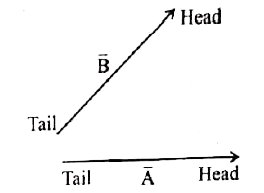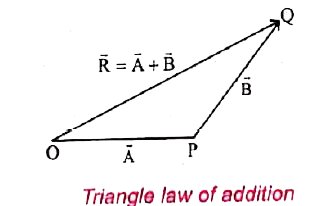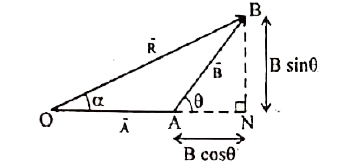Explain in detail the triangle law of addition. Solution in Tamil
Let consider two vectors →Aand→B as shown in figure.
Let us find the resultant of the two vectors apply the triangular law of addition as follows :
The vectors →Aand(B) are represented by the two adjacent sides of a triangle taken in the same order . Given the resultant the third side of the triangle. It is shown in figure.
The head of hte first vector →A is connected to the tail of the second vector →B . Let the angle between →Aand→Bbeθ.Then →R is the first vector →A to the head of the second vector →B . The magnitude of →R (resultant) is given geometrically by the length of →R (OQ) . The direction of the resultant vector is given by the angle between →Rand→A . Hence, →R=→A+→B .
−−→OQ=−−→OP+−−→PQ
(i) Magnitude of resultant vector : The magnitude and direction of the resultant vector are detemined from the following derivatives .
From the figure let us consider teh triangle ABN, that is obtained by extending the side OA to ON . ABN is a right angled triangle
From the figure .
cosθ=ANB∴AN=Bcosθand
sinθ=BNB∴BN=Bsinθ
For ΔOBN, we have
OB2=ON2+BN2
∴R2=(A+Bcosθ)2+(Bsinθ)2
⇒R2=A2+B2cos2θ+2ABcosθ+B2sin2θ
⇒R2=A2+B2(cos2θ+sin2θ)+2ABcosθ
∴R=√A2+B2+2ABcosθ
That the magnitude of the resultant of →Aand→B
(ii) Direction of resultant vectors : If θ is the angle between →Aand→B
If →R makes an angle α with →A , then in ΔOBN
tanα=BNON=BNOA+AN
⇒BsinθA+Bcosθ
∴ Its direction is given by
α=tan−1(BsinθA+Bcosθ)



Topper's Solved these Questions
- BOOK - PREMIERS PUBLISHERSCHAPTER - KINEMATICS EXERCISE - Textbook questions & answers (IV. Numerical problems).48videos
KINEMATICS
- BOOK - PREMIERS PUBLISHERSCHAPTER - KINEMATICS EXERCISE - Other important questions & answers (I.Multiple choice questions).236videos
KINEMATICS
- BOOK - PREMIERS PUBLISHERSCHAPTER - KINEMATICS EXERCISE - Textbook questions & answers (II. Short answer questions).30videos
KINEMATICS
- BOOK - PREMIERS PUBLISHERSCHAPTER - GRAVITATIONEXERCISE - OTHER IMPORTANT QUESTION & ANSWERS (CONCEPTUAL QUESTIONS)34videos
GRAVITATION
- BOOK - PREMIERS PUBLISHERSCHAPTER - KINETIC THEORY OF GASESEXERCISE - OTHER IMPORTANT QUESTIONS & ANSWERS (VI. Conceptual Questions.)8videos
KINETIC THEORY OF GASES
Similar Questions
The position vectors particle has length 1m and makes 30∘ with the x-axis. What are the lengths of the x and y components of the position vector?
20:39View SolutionKinematics is the branch of mechanics which delas with the motion of objects without taking _________ into account
06:06View SolutionWhat is meant by Cartesian coordinate system?
06:06View SolutionWhy a body weighs less at the equator than at the poles?
View SolutionWhen an automobile travels for a long distance , the air pressure in the tyres increases slightly . Why ?
06:06View SolutionTriangle Law Of Addition Of Vectors
06:06View SolutionExplain in detail the triangle law of addition.
06:06View SolutionExplain in detail the triangle law of addition.
06:06View SolutionExplain in detail the triangle law of addition.
06:06View SolutionExplain in detail the triangle law of addition.
04:29View SolutionExplain in detail the triangle law of addition.
02:49View SolutionExplain in detail the triangle law of addition.
53:48View SolutionExplain in detail the triangle law of addition.
36:30View SolutionExplain in detail the triangle law of addition.
03:03View SolutionState and explain the "triangle law of vector addition".
40:26View Solution

